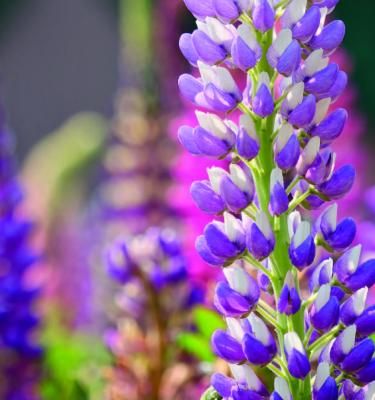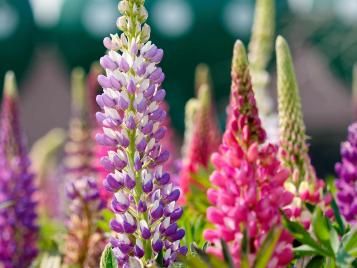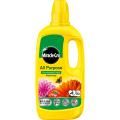

How to Grow and Care for Lupins
Lupins are a traditional addition to the garden and a must have for those with a sunny border and a cottage garden style garden. They provide stunning, colourful flowers from late spring through to mid-summer. The tall and unmistakable bright flower spikes are appreciated by humans and pollinators alike. They can be grown from cuttings, from seed or bought as a mature plant ready to go straight in the garden. If growing lupins from seed, it’s important to know that they tend not to come true so you may have a real mix of colours. To make sure you have the exact same plant it’s better to grow from basal cuttings.
What are the different varieties of lupins?
Lupins are usually classified as border lupins, or as tree lupins. Tree lupins are evergreen perennials, slightly short lived and are more shrubby looking than tree like Perennial border Lupins are the most commonly grown although you can also have annual lupins that will flower and die in the same year.
Border lupins will typically grow to about 1.5m (5') in height. Tree lupins can get much bigger than this, reaching an eventual height of 2m (7'). Border lupins will either die back in the colder months, or die completely if they are annuals.
There are over 200 types of Lupinus - here are some of our favourites:
- Lupinus albus: The field- or white-lupin, an annual which has white to pale purple flowers.
- Lupinus arboreus spp.: Also known as the tree lupin. Commonly has yellow flowers, but sometimes pale purple.
- Lupinus ‘Blossom’: Reaching an eventual height of 75cm (2.5’), this is a delicate-looking variety which produces pink and white flowers.
- Lupinus ‘Desert sun’: Pale to deep yellow flowers on this perennial lupin.
- Lupinus 'Manhattan Lights’: This perennial lupin produces flower stalks with highly contrasting colours of yellow and purple.
- Lupinus ‘Masterpiece’: One of the earliest flowering perennial lupins, this variety produces red-purple flowers, with a dab of orange, from late May onwards.
- Lupinus mutabilis: Also known as the pearl lupin. An annual variety with a purple-white flower.
- Lupinus ‘Polar Princess’: Stunning white flower heads, all traces of this plant will disappear in the winter, but it will resurface each Spring.
- Lupinus ‘Terracotta’: A perennial with peach-coloured flowers.
- Lupinus 'The Page' (Band of Nobles Series): Light red flowered perennial lupin, growing to just 1m (3’) in height.
- Lupinus ‘Towering inferno’: A perennial Lupin with deep pink-red flowers.
Lupins are in the Fabaceae family, along with other legume producing plants. They are related to peas and beans, and lupin flowers even look like peas. However, whilst some Lupinus are edible, some are very toxic. If growing for use in the kitchen, be absolutely sure that the variety is safe to eat and can be processed in a way that removes any dangerous compounds.

What you’ll need to grow lupins
To grow lupins you will need:
- Gloves.
- A plant, cutting, or seeds.
- A spade, trowel or dibber (depending on the size of the plant material).
Many lupins are poisonous, so always wear gloves when handling plants or seeds.
For instant impact, lupins can be bought ready to plant straight out into the soil. To plant straight out:
- Use the spade to a dig a hole in the border.
- Remove the Lupin from the pot, and place in the hole so that the top of the rootball is at the same level as the soil.
- Backfill the hole with soil and firm in to ensure good contact between the rootball and soil.
- Water well until new growth appears.
A cheaper alternative is to buy plug-plants from garden centres or online. They are smaller and will need a bit of TLC including potting on before planting straight out in their final positions. How to care for them:
- Water them well using a fine rose on a watering can.
- Loosely fill a 9cm (3") pot with Levington® Peat Free John Innes No.2.
- Use a dibber or pencil to create a hole in the soil.
- Place the plug-plant in the hole, fill any gaps with more compost.
- Keep moist until new growth appears, then plant out.
Lupins can also be propagated from existing plants, or grown from seed, in the spring.
Propagating from an existing lupin is best done from a ‘basal cutting’:
- Look for new shoots clustered around the base of a plant, and identify one which is 5-10cm (2-4") long.
- Use a sharp knife to cut the shoot from the main plant.
- Remove any small leaves or growth from the sides of the shoot.
- Make a hole in a small pot of cutting compost, and insert the shoot so that only the uppermost leaves are above the soil surface.
- Backfill the soil, water, and wait for it to establish, then plant out (as above).
Seeds can also be grown from seed. To sow from seed:
- Gently scratch the seed surface with a knife, and soak in water overnight.
- Fill pots with seed compost.
- Use a dibber to make a hole 2cm deep, place seed in hole.
- Cover with compost, gently tap the pot, and water until germination.
Where to plant and grow your lupins
Plant lupins out from October to April. They prefer full sun but also will grow in dappled shade but will produce slightly less Lupins will flower throughout June and July.
Lupins prefer well-drained but moist soil, however they are tolerant of many conditions and will be quite happy in sandy soil. Position them in a sheltered spot where wind will not damage the tall flower spikes.
Leaves are soft to touch, covered in tiny hairs, and pale green in colour. However, because they can be poisonous, if there are small children in the garden who may be attracted to the tactile foliage, you may want to place taller Lupins towards the back of a border.
Caring and nurturing for your lupins
Water newly planted lupins until they are established, and all lupins in hot weather. Lupins do not need regular feeding, but a fertiliser which is high in potassium will help plants to produce flowers.
Perennial border lupins should be pruned in October, cutting them back to ground level. Tree lupins are evergreen and do not need to be pruned. Deadhead all lupins when flowers have finished blooming, to encourage the production of new flower heads.
Lupins can be enjoyed inside the house by cutting fresh flower stalks and placing in a vase indoors. Keep the cut flowers out of reach of children and pets.

Common pests and diseases with lupins
Slugs and snails
Especially damaging to young plants, so protect from damage as far as possible. See our handy guide about how to get rid of Slugs and Snails.
Lupin aphid
Not usually a devastating problem, but may need managing if these grey-green pests appear in large numbers. Encourage ladybirds, birds, and other predators which will consume the aphids. Spray with a strong blast of water from the hose, and squish between fingers. Badly affected flower heads can also be removed and immersed in soapy water to kill off the aphids.
Lupin anthracnose
A fungal disease which can cause brown patches on any part of the plant. Particularly bad in wet weather, this disease will weaken the plant and can cause flower stalks to completely die off. Try to improve air flow around the plant, and use FungusClear® Ultra 2 If necessary.
Powdery mildew
Encourage air flow around plants to reduce humidity, and remove affected growth from the plant. Try not to wet the leaves when watering, direct the water at the base. Apply a fungicide such as FungusClear® Ultra 2.




